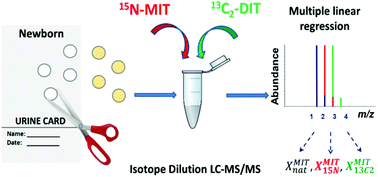Determination of 3-monoiodotyrosine and 3,5-diiodotyrosine in newborn urine and dried urine spots by isotope dilution tandem mass spectrometry†
Abstract
High levels of 3-mono- and 3,5-diiodotyrosine (MIT and DIT, respectively) in urine have been related to iodotyrosine dehalogenase 1 deficiency, a type of congenital hypothyroidism. However, the determination of MIT and DIT in urine is not included in newborn screening programs performed in clinical laboratories to detect inborn errors of metabolism. We report here on the development of an analytical method for the determination of MIT and DIT in newborn urine and dried urine spots (DUS) by Liquid Chromatography Isotope Dilution tandem Mass Spectrometry (LC-IDMSMS). The development included the synthesis of 15N-monoiodotyrosine and 13C2-diiodotyrosine through the iodination of 15N-tyrosine and 13C2-tyrosine, respectively, using bis(pyridine)iodonium(I) tetrafluoroborate (IPy2BF4). Both labelled analogues were added at the beginning of the sample preparation procedure and used to develop both single- and double-spike LC-IDMS methods for the determination of MIT and DIT. The developed double spike methodology was able to quantify and correct possible MIT ↔ DIT interconversions throughout the sample preparation, which was observed for concentrated urine samples but not for DUS. Suppression matrix effects on the absolute signals of MIT and DIT were observed in urine samples but did not affect the IDMS results as recoveries on urine samples at different dilution factors could be considered quantitative. Method detection limits were 0.018 and 0.046 ng g−1 (limits of quantification 0.06 and 0.15 ng g−1) by single-spike IDMS, for MIT and DIT, respectively, in the analysis of urine samples and 0.07 and 0.05 ng g−1 (limits of quantification 0.23 and 0.17 ng g−1) for MIT and DIT, respectively, in the analysis of DUS. No significant differences were obtained for MIT concentrations in the analysis of the same newborn samples stored as liquid urine or DUS when the results were corrected for the creatinine content. Finally, 36 DUS samples from healthy newborns were analyzed and MIT was detected in all samples at low ng mg−1creatinine levels.

- This article is part of the themed collection: Analyst HOT Articles 2022


 Please wait while we load your content...
Please wait while we load your content...